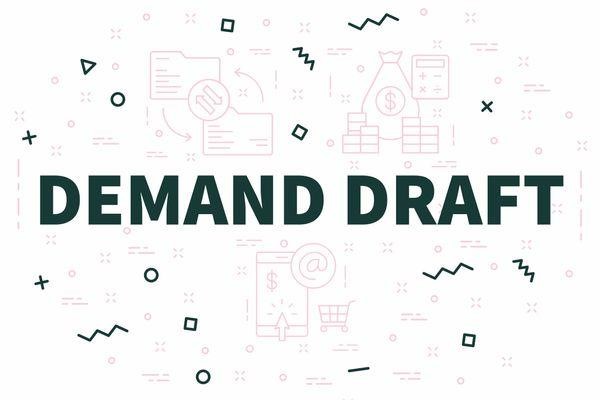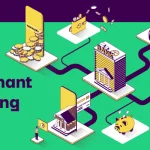What is Demand Draft – Importance, Features & Types

Despite the fact that online banking or net banking has largely replaced the traditional banking system, customers in smaller towns continue to use cheques and demand draughts as payment methods. In this blog, we have demystified the working and importance of demand draft (DD). Let’s dive in.
What is a Demand Draft (DD)?
A demand draft or DD is a payment method that is used to facilitate transactions from one bank to another. This method guarantees the payment of a specified amount to a payee whose name is mentioned on the DD.
Demand drafts cannot be issued by an individual nor can they be transferred directly to a person, meaning DDs can only be issued by a bank. Demand drafts are generally issued during large-ticket (significant sum of money) transactions or within parties who are unknown to each other. Let’s understand how DD works.
Point to Note: You don’t need your signature on the DD if you’re making the payment
How Does a Demand Draft Work?
When a bank prepares a demand draft, the amount of the draft is deducted from the customer’s account and transferred to another bank’s account. The drawer is the person who requests the demand draft, the drawee is the bank that pays the money, and the payee is the person who receives the money. Apart from providing the agreed-upon funds to the drawee upon presentation, the demand draft makes no other promises, such as earning interest. Each demand Draft has a unique code written on it to complete each transaction, which is known as the demand draft number.
What are the Details of Demand Drafts?
Take a look at the table below to check the details you need to fill up in a demand draft:
| Designated Field in Demand Draft | Details |
| To Pay | Payee’s details |
| Bank Branch | The branch which is issuing the DD |
| Amount (in words) | Amount in figures payable to the payee |
| Date | Date of the issue of the demand draft |
| DD Number | A unique number assigned to the DD |
| Signature | Signatures of the officer of the bank branch issuing the DD |
Demand Draft (DD) Form
Fill the Demand Draft with all the required details to avoid non-acceptance of the draft.
- Name and Address of the drawer (your name)
- Name of the drawee
- Name and address of the payee
- Name of the city where DD is payable
- Amount payable to the drawee (in words)
- Amount payable to the drawee (in figures)
- Exchange (fee charged by the bank)
- Total amount payable by the drawer to the bank (in figures)
- Signature of the drawer
- Name and Address of the drawer
Types of Demand Draft (DD)
There are two types of Demand Drafts:
1. Sight Demand Draft
A sight demand draft, frequently used when buying goods on the international market, is promptly payable. For instance, if a vendor sends goods to a buyer, ownership of the goods remains with the seller until the buyer receives them. A sight demand draft can be used by the buyer to quickly send funds to the seller, enabling the seller to quickly transfer ownership to the buyer.
2. Time Demand Draft
A time demand draft is not immediately payable; it has a set pay date in the future. It won’t become fully payable until a certain amount of time has passed since the payee received the goods. Some shipping businesses may use a time-demand draft in international trade. For instance, importers may release a time-demand draft to exporters. Still, the ultimate payment is not released until 15 days after the importers have received the shipment, the products, and the transfer of ownership.
How to Make Demand Drafts?
Listed below are the important points regarding how to make a demand draft:
- You can either visit your nearest bank branch or fill up the online application form on the official website.
- If you wish to pay cash for the DD, submit the form and the requisite amount.
- If you wish to pay from your bank account, do not forget to provide its details along with the payee’s name and bank address.
- You need to add important details such as currency, total amount, the reason for payment, and additional instructions if any.
- If the amount exceeds ₹50,000, you have to provide your PAN to the bank.
- Carry your ID and address proof to the bank if you wish to make a DD for a much lesser amount.
- Do not forget to check the details on DD before you leave the bank. Moreover, keep a photocopy of the DD with you before handing it over to the payee.
- Remember that you might have to pay a nominal amount of fees for the issuance of demand drafts.
Features of Demand Draft
Discussed below are the features of demand drafts:
- Demand draft is an unconditional payment order, i.e. it is payable only on demand.
- A DD does not have any stamp on it.
- A Demand draft is not directly payable to the bearer.
- A DD purchaser does not necessarily have to be a bank’s customer.
- DDs are issued only when there are sufficient funds in the bank account, which is not the case with cheques. As a result, DDs cannot bounce and are associated with safe and timely payments.
- Generally, a DD is issued when the parties involved are unknown to one another and lack trust among them.
- The amount is refunded to the initiator if the DD isn’t delivered on time.
Also Read
Charges for Demand Draft
Charges for issuing demand drafts vary from one bank to another because no amount has been fixed by the authorities. Given below are the details of DD charges:
1. Charges for Preparing DD
Generally, the charges range between ₹1.50 to ₹4 per thousand. Service tax will be applicable over the charges. Moreover, flat charges will be applicable if the amount is of a much lower value.
2. Charges for Cancellation
Cancellation charges fall anywhere between ₹100 and ₹300.
Please note that DD charges may differ for valued customers of the bank. They might receive the benefit of preferential charges.
Demand Draft Validity
The Reserve Bank of India (RBI) has issued a new guideline according to which negotiable financial instruments such as demand drafts, pay orders, and cheques will remain valid for 3 months only.
The validity period has been reduced to prevent anyone from misusing these instruments and circulating them in the market. According to RBI’s mandate, no financial institution can proceed with the necessary payments if anyone comes to them with a DD which is expired by 3 months.
However, a person can apply for revalidation of the Demand Draft by submitting the necessary application at the bank branch if the validity expires.
Things to Consider While issuing a Demand Draft
- If you intend to pay for the DD in cash, complete the DD form and pay in cash to obtain the DD.
- You must provide your PAN details to the bank for amounts exceeding Rs. 50,000
- If you intend to pay with a bank account, you must also provide those details before receiving the DD. The bank will deduct the funds and issue you the DD right away.
- Before leaving the bank, double-check the details on your DD, including the drawee’s information.
- Make a copy (photocopy or photo) of the DD before handing it over to the payee. This will be useful if there are any issues with the DD.
- You only need to present your ID and address proof to the bank for smaller amounts.
Advantages of Demand Draft
Discussed below are the advantages of using demand drafts:
- Transferring substantial amounts of money is more convenient with demand drafts. It does not have any limit on fund transfers, and one does not need to provide the payee’s information contrary to e-transfers.
- A major benefit of DDs is that you can use them for international purchases and investments.
- A demand draft is guaranteed by the issuing bank, meaning the payee is assured of payment.
- Demand drafts are difficult to forge unlike cheques making them a safer option, especially for large-value transactions.
Disadvantages of Demand Draft
Discussed below are the disadvantages of a demand draft:
- DD is valid for only 3 months, i.e. if someone fails to encash it within the valid time frame, he or she may have to undergo a lengthy revalidation process. For payees, this means missing payment for a longer time.
- The bank does not take responsibility if a demand draft is stolen and the money gets encashed by the wrong person.
- Cancellation of the demand draft is very difficult once it gets handed over to the payee. This is because the document represents a transaction that has already taken place.
Difference Between Cheque and a Demand Draft?
| Cheque | Demand Draft |
| A cheque is a written document that contains a request to the bank to pay a specific amount of money to a specific person. | A demand draft is a negotiable instrument issued by a bank in the name of a specific person or entity to transfer money from one location to another. |
| The cheque is issued by a bank customer. | A bank usually issues a demand draft. |
| Cheque must be signed by the party issuing it, whether an individual or a firm’s authorised signatory. | It bears the authorised officer’s seal and signature, as well as the bank’s rubber stamp. |
| There are 3 parties involved with a cheque | and 2 parties involved with a demand draft |
| Payable to order or to the bearer. | Always payable to a specific party on demand. |
Final Word
You can consider using demand drafts for paying large sums of money, as it is much more convenient than paying via cash or cheque. A major benefit is that you can use them for cross-border transactions. However, consider the DD validity, cancellation rules, and other factors before as a payee.
Alternatively, you can take an instant cash loan if you have urgent payments to make but are short on cash. Navi offers instant personal loans up to ₹20 Lack in a 100% paperless manner. Check your loan eligibility, apply, and get the loan amount disbursed to your bank account in minutes.
FAQs
One must visit the bank to cancel a demand draft because they are only issued after accepting payment.
If you made a cash payment, you can cancel the demand draft and receive a refund by giving the bank the original demand draft and the receipt. Keep in mind that the bank may levy cancellation fees of up to Rs 150.
If you paid by cheque for the demand draft amount, you must fill out a cancellation form and submit it with the original Draft for the money to be credited to your account.
A demand draft is good for three months from the date of issuance. The demand draft then becomes invalid. It should be noted that the funds won’t be placed into the drawer’s account even after the demand draft expires.
The drawer, who must go to the bank to revalidate the demand draft, may extend the demand draft’s expiration date by another three months. Remember that only the drawer has the authority to revalidate the demand draft, not the payee or anybody else. Additionally, it cannot be revalidated if the demand draft expires a second time.
Banks now have guidelines from the RBI on how to handle dishonest people who sign fake demand drafts. According to the rules, account payee crossover is allowed for DDs worth more than 20,000.
Since the RBI has issued strong instructions not to release a demand draft for more than 50,000 in cash, banks may only accept a limit of 49,999.
If a demand draft is misplaced or lost, banks may also generate a copy. Before issuing a new Draft, the bank assesses a small cost and nullifies the old one. Based on appropriate indemnification, the institution may release a demand draft for 5,000 or less without first receiving Non-Payment Advice.
Since they have a monetary value and are the safest payment option, demand drafts are typically used by the government and educational institutions. The drawer must make the required payment to the bank, which serves as a guarantee for the promised funds, before the Draft may be released. On the other hand, not even account payee cheques ensure that the payee will get the money.
Banks provide demand drafts regardless of the drawer’s bank account information. Regarding payments made in cash or cheques, a DD may be issued. Demand drafts issued by cheque must be drawn from a bank account.
In banking, the full form of DD is Demand Draft
A DD cannot be encashed any longer. To avoid fraudulent transactions, banks have stopped paying a drawee in cash. If you are the payee, when your bank receives a DD, the payment will be made only to your bank account.
You must fill out the DD cancellation form and submit it with the original DD. After the bank deducts the cancellation fee, the amount will be credited to your account. The amount is not automatically credited back into your account if the demand draft has expired and has not been cashed by the payee.
The limit for DD transaction is only Rs.50000 as per RBI guidelines.
A demand draft is cleared within 30 minutes.

Customer’s Feedback
No comments found.10 Best Bank for Savings Account in India [Highest Interest Rate 2023]
Savings account is a type of financial instrument offered by several banks. It lets you safely depo... Read More »What is Issuer Identification Number (IIN)- Working and Importance
What is an Issuer Identification Number (IIN)? Banks and financial institutions assign a distinc... Read More »What is a Vostro Account – Meaning, Working and Difference
What is a Vostro Account? A Vostro account is a bank account held by a domestic bank on behalf o... Read More »What is a Solvency Certificate? – Format, Documents Required & How to Apply Online?
What is a Solvency Certificate? A solvency certificate is a legal document furnishing the detail... Read More »What is Merchant Banking – Services, Features, Functions and Example
What is Merchant Banking? Merchant banking is a set of select banking and financial services off... Read More »Automated Clearing House: Objectives, Types and Process
Automated Clearing House is an electronic fund transfer network that manages automatic and direct... Read More »How to Redeem Credit Card Reward Points ?
Credit Card Reward points are types of incentives that customers receive when they use a credit car... Read More »What is Electronic Clearing Service (ECS) in Banking and How does it Work?
What is Electronic Clearing Service (ECS)? Electronic Clearing Service (ECS) is a method of elec... Read More »What are Credit Card Validators and How to Use them?
What is a Credit Card Validator? A credit card validator is a tool that checks the validity of a... Read More »What is Cash Management and How Does it Work?
Managing available capital can make sure that a small business stays afloat. Cash management is an ... Read More »What are Prepaid Expenses? – Definition, Examples, and Journal Entry
Prepaid expenses represent payments made in advance for products or services expected to be incurre... Read More »Increase Credit Card Limit – Important Tips and How to Do It?
The credit card limit is the maximum amount of money you can spend using your credit card. Your cre... Read More »Top 10 Chit Fund Schemes in India in 2023
Chit funds are one of the most popular return-generating saving schemes in India. It is a financial... Read More »10 Best Gold ETFs in India to Invest in April 2023
Gold ETFs or Gold Exchange Traded Funds are passively managed funds that track the price of physica... Read More »10 Best Demat Accounts in India for Beginners in 2023
Creation of Demat accounts revolutionised the way trades were conducted at the stock exchanges. It... Read More »20 Best Index Funds to Invest in India in April 2023
What is an Index Fund? An index fund is a type of mutual fund or exchange-traded fund (ETF) that... Read More »Best Arbitrage Mutual Funds to Invest in India in April 2023
Arbitrage funds are hybrid mutual fund schemes that aim to make low-risk profits by buying and sell... Read More »10 Best SIP Plans in India to Invest in April 2023
What is SIP? SIP or Systematic Investment Plan is a method of investing a fixed amount in ... Read More »10 Best Corporate Bond Funds in India to Invest in April 2023
Corporate bond funds are debt funds that invest at least 80% of the investment corpus in companies ... Read More »10 Best Bank for Savings Account in India [Highest Interest Rate 2023]
Savings account is a type of financial instrument offered by several banks. It lets you safely depo... Read More »





















